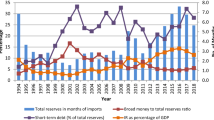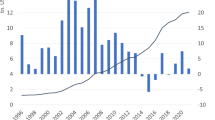Abstract
This study investigates the effect of build-up of international reserves on external debt maturity structure and exchange rate volatility in Ghana. It tests the hypotheses that the build-up of international reserves changes the maturity structure of external debt towards more long term obligation and strengthens stability in exchange rate. It also tests the hypothesis that build-up of international reserves and higher shares of long term external debt interact with each other to reinforce stability in exchange rate. An ARDL model was used to analyze data obtained from the World Bank, the International Monetary Fund and Bank of Ghana databases. The study establishes that the build-up of international reserves reduces exchange rate volatility and also interacts with higher shares of long term external debt to reinforce stability in exchange rate.


Similar content being viewed by others
References
Akita A, Karl H, Bernard L, Otker-Robe I, Canales-Kriljenko JI, Kierlenko A (2000) Capital controls: country experiences with their use and liberalization. IMF Occasional Paper 190 (Washington: International Monetary Fund)
Alesina A, Perrotti R (1995) The political economy of budget deficits. IMF Staff Papers, No. 42, pp 1–3 (Washington: International Monetary Fund)
Bahmani-Oskoee M, Hegerty SW, Hosny AS (2015) Exchange rate volatility on industry trade between the US and Egypt. Econ Change Restruct 48(2):93–117
Broner A, Lorenzoni G, Scmukler SL (2013) Why do emerging economies borrow short term? J Eur Econ Assoc 11(S1):67–100
Buch C, Lusine L (2003) Determinants of short-term debt: a note. J Int Financial Mark Inst Money 13:157–170
Canales-Kriljenko J, Habermeier K (2004) Structural factors affecting exchange rate volatility: a cross-section study. In: IMF working paper WP/04/147 (Washington DC: International Monetary Fund)
Chenery HB, Strout AM (1966) Foreign assistance and economic development. Am Econ Rev 56(4):679–733
Chinn MD, Ito H (2006) What matters for financial development? Capital controls, institutions, and interactions. J Dev Econ 81(1):163–192
Easterly W (2002) How did heavily indebted poor countries become heavily indebted? Reviewing two decades of debt relief. World Dev 30(10):1677–1696
Insah B, Chiaraah A (2013) Sources of real exchange rate volatility in The Ghanaian economy. J Econ Int Finance 5(6):232–238
Kose MA, Prasad E (2010) Emerging markets: resilience and growth amid global turmoil. Brookings Institution, Washington
Mackinnon JG (1996) Numerical distribution functioning for unit root and cointegration tests. J Appl Econom 11(6):601–618
Mayowa A, Olushola IE (2013) The determinants of real exchange rate volatility in Nigeria. Acad J Interdiscip Stud 2(1):459–471
Pesaran H, Pesaran B (2009) Time series econometrics using microfit 5. Oxford University Press, Oxford
Pesaran HM, Shin Y, Smith RJ (2001) Bounds testing approaches to the analysis of level relationships. J Appl Econom 16(3):289–326
Qian X, Steiner A (2016) International reserves, external debt maturity, and the Reinforcement effect for financial stability. In: IFO Working Paper No. 211. IFO Institute, University of Munich
Rodrick D, Velasco A (2000) Short-term capital flows. In: Proceedings of the annual World Bank conference on development economics 1999, Washington, DC: The World Bank
Schmukler S, Vesperoni E (2006) Financial globalization and debt maturity in emerging economies. J Dev Econ 79(2006):183–207
Stancik J (2007) Determinants of exchange rate volatility: the case of the new EU members. Czech J Econ Finance 57(9&10):56–72
Tambunan T, Kadin I (2006) Trade and debt interlinkages: what are the real problems in Indonesia? Retrieved from www.kadinindonesia.or.id/en/doc/opini/Trade_And_Debt_Interlinkages.pdf
Udoh JE, Akpan SB, John DE, Patrick IV (2012) Cointegration between exchange rate volatility and key macroeconomic fundamentals: evidence from Nigeria. Mod Econ 3(7):846–855
Zafar S, Butt MS (2008) Impact of trade liberalization on external debt burden: econometric evidence from Pakistan. In: MPRA Paper No. 9548, Munich Personal RePEc Archive
Zhang Z, Chan F, Xie L (2013) Accumulation of large foreign reserves in China: a behavioural perspective. Econ Change Restruct 46(1):85–108
Author information
Authors and Affiliations
Corresponding author
Rights and permissions
About this article
Cite this article
Brafu-Insaidoo, W.G. International reserves, external debt maturity and exchange rate volatility in Ghana. Econ Change Restruct 52, 181–202 (2019). https://doi.org/10.1007/s10644-017-9223-4
Received:
Accepted:
Published:
Issue Date:
DOI: https://doi.org/10.1007/s10644-017-9223-4




